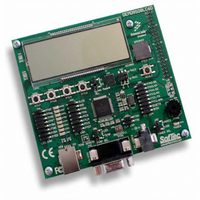DEMO9S08LC60 Freescale Semiconductor, DEMO9S08LC60 Datasheet - Page 207

DEMO9S08LC60
Manufacturer Part Number
DEMO9S08LC60
Description
BOARD DEMO FOR 9S08LC60
Manufacturer
Freescale Semiconductor
Type
MCUr
Datasheets
1.DEMO9S08LC60.pdf
(360 pages)
2.DEMO9S08LC60.pdf
(32 pages)
3.DEMO9S08LC60.pdf
(2 pages)
Specifications of DEMO9S08LC60
Contents
Evaluation Board
Processor To Be Evaluated
MC9S08LC60
Interface Type
RS-232, USB
Silicon Manufacturer
Freescale
Core Architecture
HCS08
Core Sub-architecture
HCS08
Silicon Core Number
MC9S08
Silicon Family Name
S08LC
Rohs Compliant
Yes
For Use With/related Products
MC9S08LC60
Lead Free Status / RoHS Status
Lead free / RoHS Compliant
- Current page: 207 of 360
- Download datasheet (4Mb)
Chapter 11 Timer/Pulse-Width Modulator (S08TPMV2)
In output compare or PWM modes, writing to either byte (TPMxCnVH or TPMxCnVL) latches the value
into a buffer. When both bytes have been written, they are transferred as a coherent 16-bit value into the
timer channel value registers. This latching mechanism may be manually reset by writing to the
TPMxCnSC register.
This latching mechanism allows coherent 16-bit writes in either order, which is friendly to various
compiler implementations.
11.4
Functional Description
All TPM functions are associated with a main 16-bit counter that allows flexible selection of the clock
source and prescale divisor. A 16-bit modulo register also is associated with the main 16-bit counter in the
TPM. Each TPM channel is optionally associated with an MCU pin and a maskable interrupt function.
The TPM has center-aligned PWM capabilities controlled by the CPWMS control bit in TPMxSC. When
CPWMS is set to 1, timer counter TPMxCNT changes to an up-/down-counter and all channels in the
associated TPM act as center-aligned PWM channels. When CPWMS = 0, each channel can
independently be configured to operate in input capture, output compare, or buffered edge-aligned PWM
mode.
The following sections describe the main 16-bit counter and each of the timer operating modes (input
capture, output compare, edge-aligned PWM, and center-aligned PWM). Because details of pin operation
and interrupt activity depend on the operating mode, these topics are covered in the associated mode
sections.
11.4.1
Counter
All timer functions are based on the main 16-bit counter (TPMxCNTH:TPMxCNTL). This section
discusses selection of the clock source, up-counting vs. up-/down-counting, end-of-count overflow, and
manual counter reset.
After any MCU reset, CLKSB:CLKSA = 0:0 so no clock source is selected and the TPM is inactive.
Normally, CLKSB:CLKSA would be set to 0:1 so the bus clock drives the timer counter. The clock source
for each of the TPM can be independently selected to be off, the bus clock (BUSCLK), the fixed system
clock (XCLK), or an external input. The maximum frequency allowed for the external clock option is
one-fourth the bus rate. Refer to
Section 11.3.1, “Timer x Status and Control Register
(TPMxSC)”
and
Table 11-2
for more information about clock source selection.
When the microcontroller is in active background mode, the TPM temporarily suspends all counting until
the microcontroller returns to normal user operating mode. During stop mode, all TPM clocks are stopped;
therefore, the TPM is effectively disabled until clocks resume. During wait mode, the TPM continues to
operate normally.
The main 16-bit counter has two counting modes. When center-aligned PWM is selected (CPWMS = 1),
the counter operates in up-/down-counting mode. Otherwise, the counter operates as a simple up-counter.
As an up-counter, the main 16-bit counter counts from 0x0000 through its terminal count and then
continues with 0x0000. The terminal count is 0xFFFF or a modulus value in TPMxMODH:TPMxMODL.
MC9S08LC60 Series Data Sheet: Technical Data, Rev. 4
Freescale Semiconductor
207
Related parts for DEMO9S08LC60
Image
Part Number
Description
Manufacturer
Datasheet
Request
R
Part Number:
Description:
Manufacturer:
Freescale Semiconductor, Inc
Datasheet:
Part Number:
Description:
Manufacturer:
Freescale Semiconductor, Inc
Datasheet:
Part Number:
Description:
Manufacturer:
Freescale Semiconductor, Inc
Datasheet:
Part Number:
Description:
Manufacturer:
Freescale Semiconductor, Inc
Datasheet:
Part Number:
Description:
Manufacturer:
Freescale Semiconductor, Inc
Datasheet:
Part Number:
Description:
Manufacturer:
Freescale Semiconductor, Inc
Datasheet:
Part Number:
Description:
Manufacturer:
Freescale Semiconductor, Inc
Datasheet:
Part Number:
Description:
Manufacturer:
Freescale Semiconductor, Inc
Datasheet:
Part Number:
Description:
Manufacturer:
Freescale Semiconductor, Inc
Datasheet:
Part Number:
Description:
Manufacturer:
Freescale Semiconductor, Inc
Datasheet:
Part Number:
Description:
Manufacturer:
Freescale Semiconductor, Inc
Datasheet:
Part Number:
Description:
Manufacturer:
Freescale Semiconductor, Inc
Datasheet:
Part Number:
Description:
Manufacturer:
Freescale Semiconductor, Inc
Datasheet:
Part Number:
Description:
Manufacturer:
Freescale Semiconductor, Inc
Datasheet:
Part Number:
Description:
Manufacturer:
Freescale Semiconductor, Inc
Datasheet:










